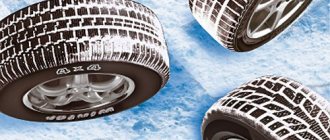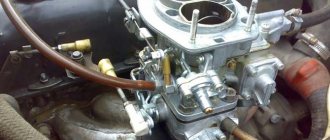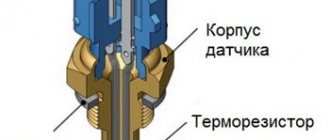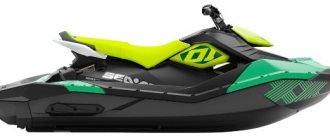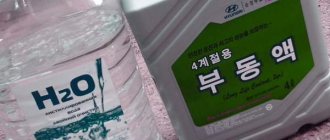- home
- Coolant
- …
Quite often I get asked questions regarding the car’s cooling system.
One of the most common ones is whether you can put regular or distilled water in there? YES, not yet an ancient car, but modern foreign cars. For me personally, it’s not entirely clear why to do this (after all, the savings are pretty cheap, as they say on the matches), but if there is a question, there will be an answer. I'll try to sort everything out. As usual, there will be text + video version... If you dig into the past (about 30 years ago), all cars drove on water and felt relatively good, then non-freezing fluids appeared (antifreeze and antifreeze) and after that the water left the radiators and cooling system generally. And I think this is correct and actually increases the life of the car.
However, if you briefly answer the question, is it possible to add water instead of antifreeze or antifreeze - the answer is YES, YOU CAN! But for a short time, in an emergency situation. In all other cases, it is better to pour special liquids.
Pros and cons of this approach
Now, to be honest, you can also pour water into the system, why not! Even from the tap! After all, water is an excellent carrier that can remove excess heat. Nothing will happen to your car instantly, but I think you can drive for about six months, but then problems will start.
- Water is everywhere, in every tap
- It's free
- Combats heat dissipation tolerably
The thing is that ordinary water is not only H2O, it also contains all sorts of salts and other impurities. Also, water does not protect metals from oxidation, rust and subsequent destruction. What else I would like to note is that now the engines of modern cars operate at temperatures above 100 degrees Celsius, for example 105 - 110, and as you know, water boils at 100, so even a working engine will boil and steam. What will this ultimately cause?
Minuses:
- The most harmless thing is scale on the walls of the pipes, a white coating like in any kettle in our apartment.
- The engine, despite the fact that it is made of aluminum alloys, and the cooling system is often made of copper and brass. It will begin to oxidize and rust, especially metal structural elements will be susceptible to this.
- Elements such as the pump, thermostat, metal adapters, etc. will be destroyed, because they are all made of metal.
- Since the water already boils at 100 degrees, air plugs form - there is a high probability that your pipes, radiators, and even the expansion tank itself will rupture; the plug may not save you.
- Do not forget that water freezes already at zero degrees, and at “-3, -4” there will be ice plugs in the system, they will simply rupture the pipes and can even damage the engine block.
As you can see, water is not at all ideal, and I would not pour it into modern cars.
When can I fill it?
However, anything can happen on the road, for example, a hose falls off, or the radiator leaks and antifreeze begins to leak out, the level drops! You can’t go on like this, you need to do something. We go to a regular supermarket, or even to the pump - we pour (purchase) water and pour it into our expansion tank without fear. This way, you will be able to make it to the service station, but after that, be sure to drain it, completely flush the system and fill in antifreeze - the one recommended for you.
In this case, this “filling” is justified! You can’t drive with an empty cooling system at all, either a tow truck, or as I indicated. You will prevent the engine from overheating and will make it to the car service normally. Of course, the most ideal thing is to find distilled water, but it is not always on hand.
Why change the housing?
Antifreeze is poured into the cooling system of modern cars. It comes in red and green. We discussed whether it is possible to mix red and green antifreeze, as well as mix antifreeze with antifreeze. There is even a video in that material where, after mixing these liquids, the mixture began to foam and pour out of the container.
Antifreeze or water, both regular and distilled, is poured into the cooling system of old cars. The volume of fluid in the system is different in different brands and models of cars.
Why change antifreeze?
Antifreeze has advantages over antifreeze and water. Its boiling point is higher and the rate at which it absorbs heat from the hot metal is higher.
Antifreeze and antifreeze should be changed because they, like motor oil, lose their anti-corrosion and physico-chemical properties.
Timely addition of fluid to the expansion tank will protect against the formation of an air lock in the cooling system.
Technological openings of radiators and pipes with long-term operation of the vehicle gradually decrease in diameter. A layer forms on the walls. All this leads to poor fluid circulation in the system.
Holes are clogged:
The expansion tank is designed to have a reserve of air space, which, in the event of boiling and an increase in the volume of coolant, is filled with excess volume. And also to determine whether antifreeze or antifreeze is leaving or not. And, of course, for filling, if necessary.
When replacing, for example, a pump or other part that requires draining, this process fluid can be reused if it is clean. But, as practice shows, the drained coolant is usually cloudy, with mechanical impurities. Some are poured back into the system after repair work and when filling, the liquid is filtered, for example, through gauze.
Distilled water
If you want, it is recommended to dilute the antifreeze concentrate ; it can be poured in a 50/50 ratio. YES and in the short term, it is also desirable for filling (I mean getting to the service station).
The thing is that distilled liquid is just H2O without any impurities (salts, etc.) that can settle in the car’s cooling system. Therefore, it is used to dilute antifreeze and antifreeze.
However, again, it’s clean, you can’t fill it, it will cause all the disadvantages that I listed above, unless there is scale! And so it oxidizes the walls, freezes, and boils beautifully. So you can't!
That’s actually the whole answer, if you compare it with old engines, which were flooded and essentially weren’t afraid, so they were repaired every year, or a maximum of two years. Back then the oils were different, there was no antifreeze, and in general the technology was, to put it mildly, far from ideal.
My late grandfather once told me - if back then those engines had oils and fluids like they do now, we would have built more! So, the people were different, they thought about the country, and not about their pockets as they do now.
That's all, sincerely your AUTOBLOGGER.
( 15 votes, average: 4.33 out of 5)
Similar news
Expansion tank cap. How it works, basic principles
Antifreeze or Antifreeze, which is better? Use - pour into it.
Protective mesh for the radiator grille. To bet or not?
Source: avto-blogger.ru
What happens if you pour water into a foreign car?
If for a short time (say for a day, two or a maximum of a week) – there will be absolutely nothing! The main thing is to then drain the water and fill it with normal (as recommended by the manufacturer - antifreeze, according to tolerances). Well, it’s worth remembering about the temperature regime of the surrounding air; if the temperature outside is sub-zero, the water will simply freeze.
It’s worth mentioning right away that modern foreign cars often have sensors that can measure the density of the coolant, even if ordinary water is filled. The engine just won't start
Thus, if you need to rest for a short time, for example, you are on the road, and there are no shops in the area, and the radiator is leaking, then pour water - the main thing is that it is clean, without dirt. Nothing bad will happen!
Is it possible to add water instead of antifreeze?
- Registration
- Entrance
- To the beginning of the forum
- Forum Rules
- Old design
- FAQ
- Search
- Users
Or the radiator won't heat up.
Z.Y. It’s a bad thing, as you know, it’s not cunning.
Yes, everything is fine, you can drive as much as you like as long as it’s warm. Of course, if you filled it with distilled water, it’s better not to use regular water at all - there will be a lot of scale. Don’t listen to anyone who will talk about lubricating the pump with antifreeze, instant rusting of the block, etc. - this is all nonsense.
Right! Listen to the “smart people” who don’t even read the factory instructions where it says it is strictly forbidden to pour water on an aluminum radiator.
You can also immediately pour engine oil into the gearbox - why waste money on the transmission.
Water into the washer. In winter, pour hot water in the morning.
If the anthers tear, just wrap them with electrical tape and that’s it. Instead of the generator eyelashes, put on women's tights.
Bendin pour 80. Why will it drive normally?
Z.Y. direct
grief advisor Mlyn.
Right! Listen to the “smart people” who don’t even read the factory instructions where it says it is strictly forbidden to pour water on an aluminum radiator.
You can also immediately pour engine oil into the gearbox - why waste money on the transmission.
Water into the washer. In winter, pour hot water in the morning.
If the anthers tear, just wrap them with electrical tape and that’s it. Instead of the generator eyelashes, put on women's tights.
Bendin pour 80. Why will it drive normally?
